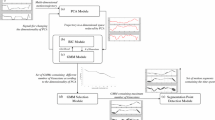Abstract
To model manipulation tasks, we propose a novel method for learning manipulation skills based on the degree of motion granularity. Even though manipulation tasks usually consist of a mixture of fine-grained and coarse-grained movements, to the best of our knowledge, manipulation skills have so far been modeled without considering their motion granularity. To model such a manipulation skill, Gaussian mixture models (GMMs) have been represented using several well-known techniques such as principal component analysis, k-means, Bayesian information criterion, and expectation-maximization (EM) algorithms. However, in this GMM, there is a problem in that when a mixture of fine-grained and coarse-grained movements is modeled as a GMM, fine-grained movements tend to be poorly represented. To resolve this issue, we measure a continuous degree of motion granularity for every time step of a manipulation task from a GMM. Then, we remodel the GMM by weighting a conventional k-means algorithm with motion granularity. Finally, we also estimate the parameters of the GMM by weighting the conventional EM with motion granularity. To validate our proposed method, we evaluate the GMM estimated using our proposed method by comparing it with those estimated by different GMMs in terms of inference, regression, and generalization using a robot arm that performs two daily tasks, namely decorating a very small area and passing through a narrow tunnel.





















Similar content being viewed by others
References
Billard A, Calinon S, Dillmann R, Schaal S (2008) Robot programming by demonstration. In: Springer handbook of robotics. Springer, New York
Levine S, Wagener N, Abbeel P (2015) Learning contact-rich manipulation skills with guided policy search. In: 2015 IEEE international conference on robotics and automation (ICRA), pp 156–163
Nemec B, Ude A (2014) Robot skill acquisition by demonstration and explorative learning. In: New trends in medical and service robots. Springer, New York
Ghalamzan E, Amir M, Paxton C, Hager GD, Bascetta L (2015) An incremental approach to learning generalizable robot tasks from human demonstrations. In: 2015 IEEE international conference on robotics and automation (ICRA), pp 5616–5621
Pais AL, Billard A (2014) Encoding bi-manual coordination patterns from human demonstrations. In: 2014 ACM/IEEE international conference on human–robot interaction, pp 264–265
Rozo L, Jiménez P, Torras C (2013) A robot learning from demonstration framework to perform force-based manipulation tasks. In: Intelligent service robotics, vol 6(1). Springer, New York, pp 33–51
Ye G, Alterovitz R (2011) Demonstration-guided motion planning. In: International symposium on robotics research (ISRR), vol 5
Ghahramani Z, Jordan M (1994) Supervised learning from incomplete data via an EM approach. Adv Neural Inf Process Syst 6:120–127
Lee SH, Han GN, Suh IH, You B (2013) Skill learning using temporal and spatial entropies for accurate skill acquisition. In: 2013 IEEE international conference on robotics and automation (ICRA), pp 1323–1330
Lee SH, Cho NJ, Suh IH (2014) Learning of motor skills based on grossness and fineness of movements in daily-life tasks. In: 2014 IEEE international conference on robotics and automation (ICRA), pp 5260–5267
Karavasilis V, Nikou C, Likas A (2015) Visual tracking using spatially weighted likelihood of gaussian mixtures. In: Computer vision and image understanding, pp 1–15
Malekzadeh MS, Bruno D, Calinon S, Nanayakkara T, Caldwell DG (2013) Skills transfer across dissimilar robots by learning context-dependent rewards. In: 2013 IEEE/RSJ international conference on intelligent robots and systems (IROS), pp 1746–1751
Jing L, Ng M, Huang J (2007) An entropy weighting \(k\)-means algorithm for subspace clustering of high-dimensional sparse data. IEEE Trans Knowl Data Eng 19(8):1026–1041
Kerdprasop K, Kerdprasop N, Sattayatham P (1992) Weighted \(k\)-means for density-biased clustering. Data Warehous Knowl Compon Ecol Var 73(3):1045–1055
Eddy SR (1995) Multiple alignment using hidden Markov models. In: AAAI, pp 114–120
Hersch M, Guenter F, Calinon S, Billard A (2008) Dynamical system modulation for robot learning via kinesthetic demonstrations. IEEE Trans Robot 24(6):1463–1467
Calinon S, Guenter F, Billard A (2007) On learning, representing, and generalizing a task in a humanoid robot. IEEE Trans Syst Man Cybern Part B Cybern 37(2):286–298
Lee SH, Suh IH, Calinon S, Johansson R (2015) Autonomous framework for segmenting robot trajectories of manipulation task. Auton Robot 38(2):107–141
Basheer IA, Hajmeer M (2000) Artificial neural networks: fundamentals, computing design, and application. J Microbiol Methods 43(1):3–31
Fritsch FN, Carlson RE (1980) Monotone piecewise cubic interpolation. SIAM J Numer Anal 17(2):238–245
Jamone L, Damas B, Santos-Victor J (2014) Incremental learning of context-dependent dynamic internal models for robot control. In: 2014 IEEE international symposium on intelligent control (ISIC), pp 1336–1341
Artemiadis PK, Kyriakopoulos KJ (2011) A switching regime model for the EMG-based control of a robot arm. IEEE Trans Syst Man Cybern Part B Cybern 41(1):53–63
Kulic D, Takano W, Nakamura Y (2007) Incremental learning, clustering, and hierarchy formation of whole body motion patterns using adaptive hidden Markov chains. Int J Robot Res 27(7):761–784
Calinon S, Billard A (2007) Incremental learning of gestures by imitation in a humanoid robot. In: 2007 ACM/IEEE international conference on human–robot interaction, pp 255–262
Kronander K, Khansari-Zadeh M, Billard A (2011) Learning to control planar hitting motions in a minigolf-like task. In: 2011 IEEE/RSJ international conference on intelligent robots and systems (IROS), pp 710–717
Silvério J, Rozo L, Calinon S, Caldwell DG (2015) Learning bimanual end-effector poses from demonstrations using task-parameterized dynamical systems. In: 2015 IEEE/RSJ international conference on intelligent robots and systems (IROS), pp 464–470
Cederborg T, Li M, Baranes A, Oudeyer P (2010) Incremental local online Gaussian mixture regression for imitation learning of multiple tasks. In: 2010 IEEE/RSJ international conference on intelligent robots and systems (IROS), pp 267–274
Author information
Authors and Affiliations
Corresponding author
Additional information
N. J. Cho and S. H. Lee contributed equally to this work.
Electronic supplementary material
Below is the link to the electronic supplementary material.
Supplementary material 1 (mp4 32543 KB)
Supplementary material 2 (mp4 17555 KB)
Rights and permissions
About this article
Cite this article
Cho, N.J., Lee, S.H. & Suh, I.H. Modeling and evaluating Gaussian mixture model based on motion granularity. Intel Serv Robotics 9, 123–139 (2016). https://doi.org/10.1007/s11370-015-0190-1
Received:
Accepted:
Published:
Issue Date:
DOI: https://doi.org/10.1007/s11370-015-0190-1




